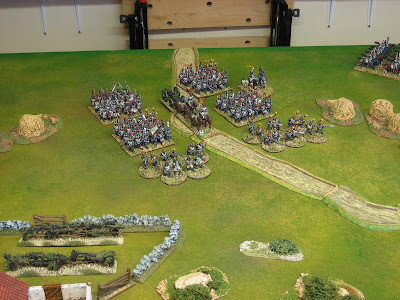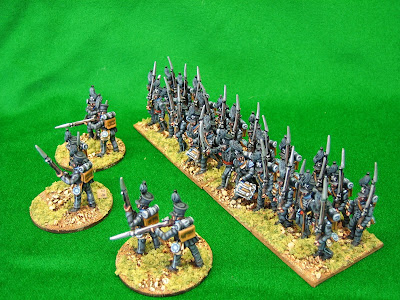Edit: I've followed this post with a revised scenario. This post is still needed for OOB.
For my first 'historical' Peninsular battle scenario, I have chosen Vimeiro 1808. I've chosen it partly because I have enough figures to do it (at my chosen scale, more anon), partly because I can do it all on one table, and partly because it's an interesting battle.
That said, this is not going to be a recreation of the battle in any real sense. Although I'm using historic numbers, and the terrain and deployments are not too far away from [the feel of] those which framed the battle, I'm going to play around with time to a large degree.
Historically, Vimiero was actually two combats that were isolated from each other by both time and distance. Firstly, there was the combat for Vimeiro and its associated hill. Then, sometime later in the day, there was the combat for the eastern end of the Eastern ridge, which was itself two combats, with the second following after the first French attack had been successfully beaten off and the British had recovered their composure. In short, the outnumbered French attacked piecemeal and paid the price for it.
My 'what if' scenario poses that all of the attacks happened at roughly the same time. The British on the Eastern Ridge will lose their historical local superiority of numbers and give the French a chance of victory. Ding dong, that's a game!
With both combats fought simultaneously the battle will be perfect for four players; no one will be left twiddling thumbs, waiting for his time to arrive, whilst the others have fun. My plan is for two players to face off for Vimeiro and Vimeiro Hill; whilst two players face off for the Eastern ridge. Essentially, my 'What if' Vimeiro scenario will remain two separate combats.
 |
| The set up for 'What if' Vimeiro 1808. BTW. I did make a schoolboy error when I set this game up: The room wall should be at the other end of the table, so to speak. |
Before I get down to the scenario notes proper, I just want to run my scaling method past you again because it does throw up some anomalies, and more in this case than usual.
Rather than go the route of scaling units and having units of various sizes (much favoured by most Napoleonic players), I have decided to fly in the face of conventional wisdom: I have chosen to have units all one size, with each infantry unit representing 1000 men, and to forget the actual granular nature of brigades and divisions. E.g. Regardless of how many battalions made up a division, I will represent every 1000 men present with an infantry unit, every 500 troopers with a cavalry unit; fractions will be rounded, naturally.
This battle is a bit strange because of the number of large units (over 1000 men each) engaged. Normally I will end up with divisions fielding less units than would be historically present, and given that "I'm scaling" most wargamers would accept this without much of a to do: But, at Vimeiro, some formations have more units than they historically should. E.g. Solignac should really only have three battalions but, using my scaling method, his 4,000 men gives him four; Brenier should have four battalions but has five for similar reasons. This doesn't bother me very much but, I don't want to confuse anyone with my OOB without first explaining how I got there.
Another thing I have done, to concentrate effort and make the game less granular than it otherwise might be, is to combine certain brigades into ad hoc divisions with one division, rather than two brigade, command stands. Normally I would organise things at divisional level rather than brigade level, so where two brigades are to undertake the same task, in the same local, I have combined them. An example would be the defence of the eastern end of the Eastern Ridge by Nightingall and Furgusson: Historcally the two brigades worked closely together to achieve this so I have formed both brigades into a division under the combined command (one command stand) of both officers. Other examples of my ad hoc division making can be seen in the photograph above.
British Briefing:
Wellesley: Commander-in-Chief stand: Superior (2 Brilliant Leader cards). 12 Army Morale Points (AMP). 6 Transferable Divisional Morale Points (TDMP).
Victory Conditions: You are the holding the bridgehead in Portugal which will allow reinforcements to pour ashore from Britain. You must repel the French at all costs by holding Vimeiro and Vimeiro Hill. If you fail, you will be thrown back into the sea.
Anstruther's and Fane's Brigades (Division), 5,200 men: |
| British riflemen hold the vineyards on the lower slopes ofVimeiro Hill; they are backed by the line and light infantry battalions of Fane and Anstruther. |
Victory Conditions: You must destroy the army currently defending the British bridgehead in Portugal before their reinforcements arrive in overwhelming force: Throw them back into the sea!
 |
| The massed columns of the French prepare for the assault. |
 |
| The view from behind Vimeiro, with the Eastern Ridge extending out into the distance. (Table is 12' x 6'). |
- The hills are rough (steep slopes) terrain.
- The walled fields are very rough terrain; they provide soft cover. Regardless of type they do not block line of sight - historically, I suspect most would be low vineyards and the like (?) but grape vines are something I'm woefully short of - note to self: Make more! There do not appear to be any stone walls in the area today so I suspect there have never been.
- Town sections should be treated as standard stone buildings with normal capacity.
- The R. Maceira and its tributary (for want of better information) are very rough terrain, the Maceira itself is 'wet'.



























